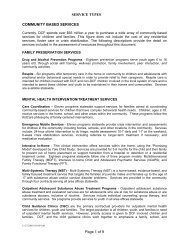Coastal Structures: Types, Functions And Applications
Coastal Structures: Types, Functions And Applications
Coastal Structures: Types, Functions And Applications
Create successful ePaper yourself
Turn your PDF publications into a flip-book with our unique Google optimized e-Paper software.
<strong>Coastal</strong> <strong>Structures</strong>:<br />
<strong>Types</strong>, <strong>Functions</strong> and <strong>Applications</strong><br />
US Army Corps of Engineers<br />
Presentation to Shoreline Erosion Task Force<br />
August 15, 2012<br />
Hartford, CT<br />
1
Session Objectives<br />
<strong>Coastal</strong> Structure <strong>Types</strong> & <strong>Functions</strong>:<br />
Understand fundamental concepts of coastal<br />
structures and how they provide protection.<br />
2
SOFT v.s. HARD<br />
(Erodable v.s. Nonerodable)<br />
Beachfill<br />
Dunes<br />
Marshes<br />
Bioengineered<br />
geotubes<br />
are in<br />
between<br />
Seawalls<br />
Revetments<br />
Breakwaters<br />
Jetties<br />
Groins<br />
Bulkheads<br />
3
What Do <strong>Coastal</strong> <strong>Structures</strong> Do<br />
1. Stop water<br />
1a. Stop flooding<br />
1b. Stop impact<br />
2. Hold soil<br />
2a. Hold upland soil<br />
2b. Slow down sand transport<br />
• Protect infrastructure from flooding due to high<br />
water levels, erosion, and impact from waves and currents<br />
• Protect boat traffic by reducing waves and wave<br />
impact<br />
• Stabilize navigation channels by reducing<br />
sedimentation, inlet migration<br />
• Reduce erosion by stabilizing shorelines/beaches<br />
• Enhance recreation, beauty<br />
4
Advantages of Hard <strong>Structures</strong><br />
v.s. Soft<br />
• Withstand larger forces<br />
• Resist erosion - consider hard structures if<br />
erosion > 3 ft/yr<br />
• Less footprint area<br />
• Reduce renourishment needs/costs<br />
– Help extend available sand resources<br />
• Function in deep water<br />
• Transition to existing shore over short distances<br />
• Tend to last longer<br />
5
<strong>Coastal</strong> <strong>Structures</strong><br />
Functional Areas<br />
1. <strong>Coastal</strong> armoring structures resist<br />
waves, scour, overtopping<br />
2. Beach or soil stabilization structures<br />
hold upland sediment, retard alongshore<br />
transport<br />
3. Navigation structures resist waves,<br />
currents, sedimentation<br />
6
1. <strong>Coastal</strong> Armoring <strong>Structures</strong><br />
More is more<br />
• Seawalls<br />
• Revetments<br />
• Bulkheads<br />
Largest<br />
Medium<br />
Smallest<br />
7
Seawalls<br />
• Prime objective is to<br />
protect upland<br />
infrastructure from<br />
flooding, wave impact and<br />
overtopping<br />
• Secondary function is to<br />
hold fill (bluff, shoreline) in<br />
place<br />
O’Shaughnessy<br />
Seawall,<br />
San Francisco, CA<br />
• Generally massive. Often<br />
high. Often long.<br />
• High wave energy<br />
application<br />
8
Seawalls<br />
•Often concrete<br />
•May be rubblemound<br />
or other materials<br />
•Tend to be freestanding<br />
with backfill,<br />
gravity or pile<br />
supported<br />
•Scour protection<br />
integral<br />
Galveston seawall, TX<br />
9
Galveston Seawall during construction, 1905. Built following<br />
Galveston Hurricane of 1900. (image from Wikipedia)<br />
10
Scour protection<br />
Seawalls<br />
Typical crosssections<br />
(EM1110-2-1614)<br />
11
Seawalls<br />
Waves breaking over<br />
Sea Bright NJ seawall<br />
Curved concrete seawall<br />
La Jolla, CA<br />
Curve directs waves away<br />
from infrastructure<br />
12
Seawall<br />
Hereford Inlet,<br />
NJ<br />
Wall added for<br />
overtopping<br />
protection<br />
13
Seawalls<br />
When would you want major armoring<br />
•Very valuable upland infrastructure<br />
•Harsh wave conditions, high surge<br />
•Cannot provide protection further<br />
offshore, for example with an offshore<br />
breakwater<br />
14
Digression #1: Three coastal damage mechanisms – flooding, erosion, wave attack<br />
People understand flooding,<br />
but what exactly is “wave attack”<br />
Wave attack is impact from waves. Water is heavy, plus waves have<br />
forward velocity. To illustrate:<br />
1 cubic foot = 7.48 gallons<br />
1 cubic foot = 64 pounds<br />
2 cubic feet = 128 pounds<br />
15
Rule of Thumb<br />
Repeated impact from 3-ft waves during a<br />
storm can destroy a small house.<br />
16
Heavier seawall materials can<br />
withstand wave impact<br />
Concrete<br />
Rock<br />
Steel<br />
1 cubic foot = 145 pounds<br />
(more than me)<br />
1 cubic foot = 165 pounds<br />
1 cubic foot = 490 pounds<br />
Sand (dry)<br />
1 cubic foot = 100 pounds<br />
17
Wave Impact on the Structure<br />
• Waves impact the face of<br />
structure<br />
• Overtopping also impacts the<br />
top & back of the structure<br />
• Scour impacts the toe<br />
18
What is overtopping<br />
Overtopping is water that splashes<br />
above and landward of the line of<br />
protection.<br />
Lajes, Azores Breakwater (image from Jeff Melby)<br />
19
What does overtopping do<br />
Impact from overtopping water can cause direct damage to upland<br />
infrastructure, and can remove material from behind structures, causing<br />
structure failure. Overtopped water floods behind line of protection.<br />
ASHAROKEN 15 Mar 2010<br />
Removes unprotected soil<br />
from behind structure, fails<br />
structure<br />
Damage reaches to far side of<br />
roadway<br />
20
Scour: loss of<br />
material at the toe<br />
Wave form is<br />
traveling forward<br />
Structure stops forward<br />
motion of wave,<br />
reflects it back,<br />
increasing wave height<br />
Moving water digs out<br />
sand - bottom scours<br />
But water particles<br />
go in circular paths<br />
Friction from sloping bottom<br />
slows down water particles,<br />
wave steepens (may break)<br />
21
‣Common experience<br />
of scour – standing still<br />
at waters edge, waves<br />
dig out around your<br />
feet, you sink.<br />
Scour<br />
Rule of Thumb:<br />
Scour depth will equal<br />
reflected wave height<br />
Scour protection likely to be<br />
comparable in size to upper<br />
part of seawall<br />
22
<strong>Coastal</strong> Armoring:<br />
Revetments<br />
• Purpose is to protect<br />
the shoreline against<br />
erosion<br />
• Function by<br />
reinforcing of part of<br />
the beach profile<br />
• “Medium” crosssection<br />
size. Can be<br />
long.<br />
Barnegat North<br />
• Generally built on<br />
existing slope<br />
• Often rubblemound<br />
23
Revetments<br />
Materials: Rock, concrete<br />
Layered on existing slope<br />
24
Digression #2:<br />
How to Build a Rubblemound Structure<br />
Water<br />
Existing Bottom<br />
1<br />
25
How to Build a Rubblemound Structure<br />
3. Place bedding stone to smooth<br />
bottom, provide gradation<br />
2. Place geotextile to control<br />
loss of fines, spread load<br />
1.Excavate if needed<br />
2<br />
26
How to Build a Rubblemound Structure<br />
Place large toe stones<br />
3<br />
27
How to Build a Rubblemound Structure<br />
Place core stone<br />
4<br />
28
How to Build a Rubblemound Structure<br />
Place armor stone<br />
5<br />
29
Revetments<br />
Materials: Other<br />
Gabion Revetment<br />
Cape May Pt, NJ<br />
Geotube® revetment<br />
31
Revetments<br />
Fort Fisher, NC before<br />
Fort Fisher, NC after<br />
Road protection<br />
Photos: Williams Dennis SAW<br />
32
Bulkheads • Objective is to<br />
retain upland<br />
soil<br />
• Function is<br />
reinforcement<br />
of the soil<br />
bank<br />
• Steel,<br />
concrete,<br />
timber, vinyl,<br />
composite<br />
• “small”<br />
33
Bulkheads<br />
Anchored<br />
Anchor pile<br />
Tie rod<br />
Sheeting<br />
34
Bulkheads<br />
Cantilever<br />
35
Bulkheads<br />
Bulkheads: “Every homeowner for himself!”<br />
Coney Island, 1990<br />
36
Bulkheads<br />
Timber bulkhead at Bradley Beach, NJ<br />
under direct wave attack<br />
Tie-back section to<br />
landside closure<br />
Rock placed at the base of the structure to prevent scour,<br />
sometimes placed to reinforce bulkhead.<br />
37
<strong>Types</strong> of <strong>Coastal</strong> <strong>Structures</strong><br />
1. <strong>Coastal</strong> armoring structures<br />
2. Beach or soil stabilization structures<br />
3. Navigation structures<br />
38
Beach or Soil Stabilization<br />
<strong>Structures</strong><br />
• Nearshore breakwaters<br />
• Groins<br />
• Reefs and sills (“perched beach”)<br />
• Containment dikes<br />
39
Nearshore (Detached) Breakwaters<br />
• Purpose is to prevent<br />
shoreline erosion<br />
• Function is reduction<br />
of wave energy in lee<br />
and reduction of<br />
longshore transport<br />
• Parallel to shoreline<br />
• Allow some<br />
alongshore transport<br />
40
Nearshore (Detached) Breakwaters<br />
Presque Isle, PA<br />
41
Nearshore Breakwaters<br />
Maumee Bay State Park<br />
Lake Erie<br />
42
Groins<br />
• Purpose is to reduce beach erosion, or terminate a beach fill<br />
• Function by trapping or slowing down longshore transport.<br />
• Generally perpendicular to shoreline<br />
• Designed to both hold back sand and allow transport, to reduce<br />
downdrift impacts<br />
43
Groins<br />
• Not jetties!<br />
• Trap % of longshore transport, if transport exists<br />
• Most effective when combined with beach fill<br />
• Usually constructed in groups or groin fields<br />
• Terminal groins anchor beach or limit sand into<br />
navigation channel<br />
• <strong>Types</strong> include notched, permeable, adjustable,<br />
T/L/Y shaped<br />
• Varied types of construction materials<br />
44
Groin Geometries<br />
(Figure: CHL Website)<br />
45
Groins<br />
Overhead view of<br />
a rock groin<br />
showing the<br />
underwater<br />
extent of the<br />
structure<br />
46
Groin Field<br />
Long Branch and Deal, NJ 1987<br />
Allenhurst, Loch Arbour, Asbury<br />
Park, NJ 1987<br />
47
Groins<br />
Terminal groin<br />
Buried groin field<br />
Coney Island terminal groin (w/beach)<br />
48
Digression #3:<br />
How does sand travel in water<br />
• Rolling along the bottom (bed load)<br />
• Floating in the water column<br />
(suspended)<br />
• Saltation, or hopping<br />
Sand travels mostly between<br />
depth of closure and landward<br />
limit of flow<br />
49
How does sand move past a groin<br />
Sand can only travel where the water flows<br />
2. Over<br />
3. Through<br />
4. Around<br />
landward end<br />
1. Around<br />
seaward end<br />
50
To add permeability to a groin:<br />
• Lower the crest<br />
• Shorten seaward extent<br />
• Shorten landward extend<br />
• Use material with voids<br />
To reduce permeability:<br />
• Raise the crest<br />
• Lengthen seaward extent<br />
• Lengthen landward extend<br />
• Eliminate voids<br />
51
Reefs and Sills<br />
• Purpose is to limit<br />
beach erosion<br />
• Reef breakwaters<br />
function by reducing<br />
waves at the fill toe<br />
• Submerged sills are<br />
used to slow offshore<br />
movement of sand,<br />
shorten fill profile<br />
• Often used inside<br />
groin compartments<br />
52
Reefs and Sills<br />
Used with or<br />
Without beach fill<br />
53
Double-T Units & Scour Apron<br />
54
Placement of Double T Unit<br />
55
“Beachsaver”<br />
Units<br />
Patented shape®<br />
56
Other Technologies<br />
• Holmberg Beach Technologies<br />
• Sand Rx, Sand Castle Technologies<br />
• Beach/Dune Dewatering<br />
57
Containment Dikes<br />
•Stabilize perimeters of<br />
marshes, disposal islands<br />
58
Branch Box Breakwaters<br />
59
<strong>Types</strong> of <strong>Coastal</strong> <strong>Structures</strong><br />
• <strong>Coastal</strong> armoring structures<br />
• Beach stabilization structures<br />
• Navigation structures<br />
60
Navigation <strong>Structures</strong><br />
• Breakwaters<br />
• Jetties<br />
Repair of North Jetty Yaquina, Oregon (2000)<br />
61
-Smaller vessels are more affected by<br />
waves<br />
-Larger vessels are more affected by<br />
currents<br />
-Faster moving vessels are less at risk than<br />
slower moving vessels<br />
-Vessels generally have to slow down and<br />
turn to enter channels<br />
62
Navigation Breakwaters<br />
• Purpose is to shelter<br />
harbor basins and<br />
entrances against<br />
waves and currents<br />
primarily for boat<br />
traffic<br />
Marina del Rey, CA<br />
• Function by<br />
dissipating and<br />
reflecting wave<br />
energy<br />
63
Jetties<br />
Acting as breakwaters<br />
Source: Heidi Moritz, Portland District<br />
64
Breakwaters and Jetties<br />
Ventura Harbor, CA<br />
65
Jetties<br />
Barnegat Inlet, NJ<br />
(new south jetty)<br />
•Purpose is to reduce sedimentation of channels<br />
•Shelter harbor basins and entrances against<br />
waves and currents<br />
•Limit inlet migration<br />
66
Jetties<br />
As with groins, geometry can vary<br />
Spur Jetties Siuslaw River, OR<br />
67
Jetties (Dolos/CoreLoc)<br />
Manasquan Inlet, NJ<br />
Concrete units may be cost effective vs. large stone<br />
68
Core-Loc units at Manasquan Inlet<br />
Jetty, NJ<br />
69
Floating Breakwaters<br />
• Purpose is to<br />
shelter harbor<br />
basins and<br />
mooring areas<br />
Floating Breakwater<br />
RIBS System<br />
• Reduce waves<br />
by reflection<br />
and breaking<br />
70
Combination of <strong>Structures</strong> (Systems)<br />
Submerged Breakwater<br />
Beach fill<br />
Groins<br />
Revetment with walk way<br />
Chicago, 31st Beach<br />
71
Construction of first hydraulically pumped beachfill at<br />
Coney Island NY, 1922<br />
Essayons!<br />
72












